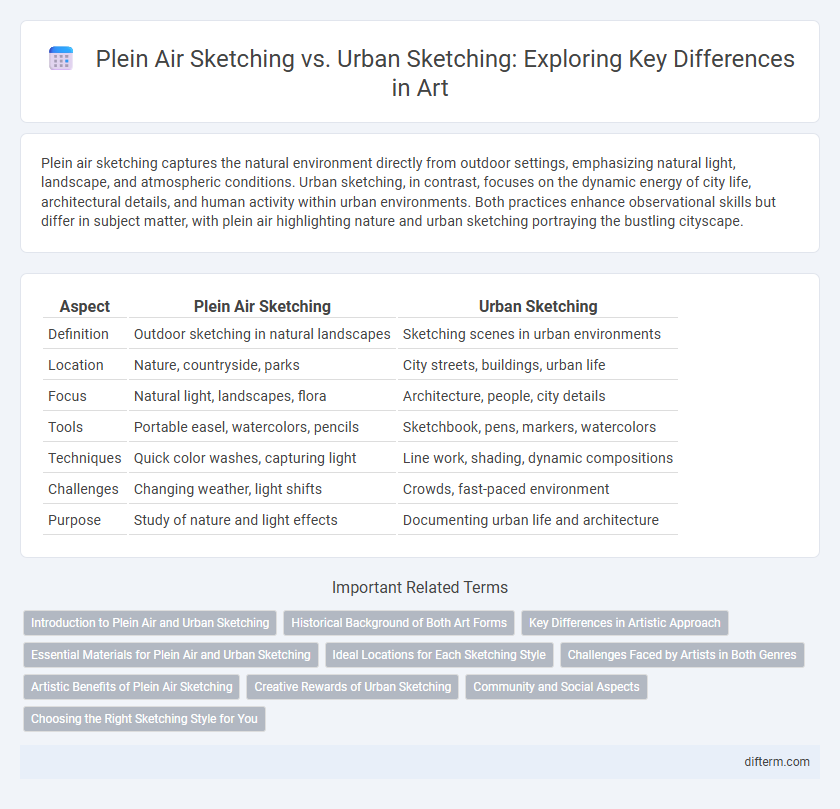Plein air sketching captures the natural environment directly from outdoor settings, emphasizing natural light, landscape, and atmospheric conditions. Urban sketching, in contrast, focuses on the dynamic energy of city life, architectural details, and human activity within urban environments. Both practices enhance observational skills but differ in subject matter, with plein air highlighting nature and urban sketching portraying the bustling cityscape.
Table of Comparison
| Aspect | Plein Air Sketching | Urban Sketching |
|---|---|---|
| Definition | Outdoor sketching in natural landscapes | Sketching scenes in urban environments |
| Location | Nature, countryside, parks | City streets, buildings, urban life |
| Focus | Natural light, landscapes, flora | Architecture, people, city details |
| Tools | Portable easel, watercolors, pencils | Sketchbook, pens, markers, watercolors |
| Techniques | Quick color washes, capturing light | Line work, shading, dynamic compositions |
| Challenges | Changing weather, light shifts | Crowds, fast-paced environment |
| Purpose | Study of nature and light effects | Documenting urban life and architecture |
Introduction to Plein Air and Urban Sketching
Plein air sketching emphasizes capturing natural landscapes directly from outdoor settings, highlighting changing light and atmosphere. Urban sketching centers on documenting city life and architecture through on-location drawings, showcasing dynamic urban environments. Both practices engage artists with immediate surroundings, enhancing observational skills and authenticity in their artwork.
Historical Background of Both Art Forms
Plein air sketching originated in the 19th century with Impressionist painters who sought to capture natural light and landscapes directly outdoors, emphasizing spontaneity and atmospheric effects. Urban sketching emerged more recently as a global movement in the 21st century, focusing on documenting cityscapes, architecture, and everyday urban life through on-location drawing. Both art forms share a commitment to depicting real-world scenes in situ, but plein air emphasizes natural environments while urban sketching centers on dynamic urban settings.
Key Differences in Artistic Approach
Plein air sketching emphasizes capturing natural light, atmosphere, and landscapes directly from outdoor settings, focusing on changing environmental conditions and organic forms. Urban sketching centers on depicting cityscapes, architecture, and human activity, highlighting structural details and dynamic urban scenes with a narrative quality. Both approaches demand rapid observational skills but differ in subject matter, compositional challenges, and the interplay of natural versus constructed environments.
Essential Materials for Plein Air and Urban Sketching
Essential materials for plein air sketching include a portable easel, durable sketchbook, watercolor or oil paints, brushes, and a palette designed for outdoor use, ensuring artists can capture natural light and scenery efficiently. Urban sketching requires compact and lightweight tools such as a small sketchbook, waterproof pens, pencils, and travel-friendly watercolors, allowing artists to quickly document dynamic city scenes. Both styles benefit from carrying a folding stool, a water container, and weather-appropriate attire to maintain comfort and flexibility while working on location.
Ideal Locations for Each Sketching Style
Plein air sketching thrives in natural settings such as parks, countryside landscapes, and coastal areas, where artists capture changing light and atmospheric conditions directly from nature. Urban sketching excels in bustling cityscapes, featuring detailed architecture, streetscapes, and everyday urban life scenes that highlight human activity and infrastructure. Ideal locations for plein air focus on serene, open-air environments, whereas urban sketching benefits from dynamic city hubs offering diverse visual elements and social interactions.
Challenges Faced by Artists in Both Genres
Plein air sketching presents challenges such as rapidly changing natural light, unpredictable weather conditions, and the need to capture expansive landscapes quickly, demanding strong observational skills and adaptability. Urban sketching requires artists to navigate crowded public spaces, manage varying architectural details, and often contend with time constraints imposed by passersby or city regulations. Both genres test an artist's ability to balance detail with spontaneity while working in dynamic environments.
Artistic Benefits of Plein Air Sketching
Plein air sketching enhances artists' ability to capture natural light, color variations, and atmospheric conditions in real time, fostering a deeper connection with the environment. This practice sharpens observational skills and encourages spontaneous creativity by challenging artists to work quickly and adapt to changing surroundings. Immersion in natural settings also promotes mindfulness and emotional expression, enriching the overall artistic experience.
Creative Rewards of Urban Sketching
Urban sketching offers unique creative rewards by capturing the dynamic essence of city life through on-the-spot observation, fostering spontaneity and authenticity in artworks. Artists engage directly with diverse urban environments, blending architectural details, human activity, and changing light to produce vibrant, narrative-rich sketches. This practice not only enhances visual storytelling skills but also cultivates a deep connection to cultural and social contexts inherent in metropolitan settings.
Community and Social Aspects
Plein air sketching fosters a close-knit community of artists who gather in natural settings, encouraging collaboration and shared observation of landscapes, enhancing artistic growth through collective experience. Urban sketching cultivates vibrant social interactions by inviting artists to capture the dynamic life of cities, promoting cultural exchange and storytelling through public art. Both forms strengthen community bonds by encouraging artists to connect, share techniques, and inspire one another in diverse environments.
Choosing the Right Sketching Style for You
Plein air sketching captures natural landscapes directly from outdoor settings, emphasizing light, atmosphere, and natural elements. Urban sketching focuses on cityscapes, architecture, and dynamic human activity, offering vibrant, detailed depictions of urban environments. Choosing the right style depends on your subject interest, preferred environment, and whether you seek tranquil nature scenes or energetic urban life in your artwork.
Plein air sketching vs Urban sketching Infographic

 difterm.com
difterm.com